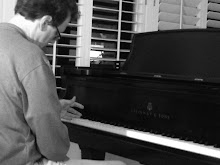Beta Collide performance of "not here, not now"
Thrilling to hear Beta Collide perform my new piece. Thank you, thank you Molly & Matthew.
I've included a reasonably high quality recording of the performance as well as the final score. The context for the concert, once more, was a series of pieces composed in response to Professor Mark Applebaum's "Theme in Search of Variations III". I chose to limit my piece to only two of the four ensemble members (flute and piano), in part because I wanted to focus on the resonance of the piano in this piece which would require a muted dynamic, but also I saw an opportunity to use the exercise as a means to justify writing a long-anticipated slow movement to my first piano sonata. The use of flute and piano in a piano sonata indeed has precedence!
The structure follows my other movements, but with an Applebaum twist. Mark's piece build on a structure of rotating ambiguity in time and space. In my piece, I adopt this same table, but create ambiguity around harmonic center. The hope is that in a very subtle and nuanced way, the resonance of the piano pulls the harmonic center down, up, or possibly reenforces that center. This harmonic center itself is somewhat ambiguous given the polytonal structure. A study of the score, however, would reveal certain pitches and harmonies that are re-enforced and implied by the open bass strings. The metric structure, following the form of my other movements, has the piano in five versus the flute in three. In the central dopio movemento, the briefly align on 4.
not here, not now
not here, not now score
I've included a reasonably high quality recording of the performance as well as the final score. The context for the concert, once more, was a series of pieces composed in response to Professor Mark Applebaum's "Theme in Search of Variations III". I chose to limit my piece to only two of the four ensemble members (flute and piano), in part because I wanted to focus on the resonance of the piano in this piece which would require a muted dynamic, but also I saw an opportunity to use the exercise as a means to justify writing a long-anticipated slow movement to my first piano sonata. The use of flute and piano in a piano sonata indeed has precedence!
The structure follows my other movements, but with an Applebaum twist. Mark's piece build on a structure of rotating ambiguity in time and space. In my piece, I adopt this same table, but create ambiguity around harmonic center. The hope is that in a very subtle and nuanced way, the resonance of the piano pulls the harmonic center down, up, or possibly reenforces that center. This harmonic center itself is somewhat ambiguous given the polytonal structure. A study of the score, however, would reveal certain pitches and harmonies that are re-enforced and implied by the open bass strings. The metric structure, following the form of my other movements, has the piano in five versus the flute in three. In the central dopio movemento, the briefly align on 4.
not here, not now
not here, not now score


0 Comments:
Post a Comment
<< Home